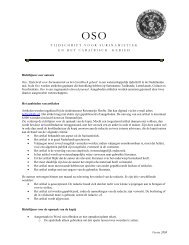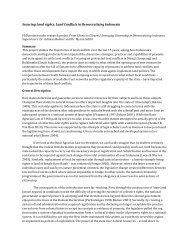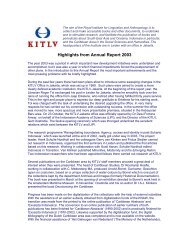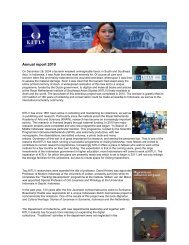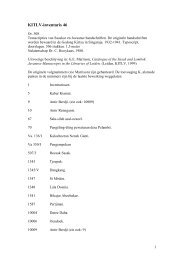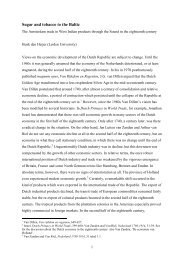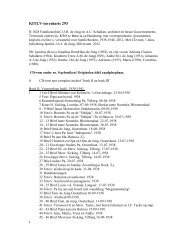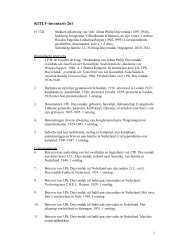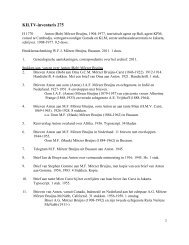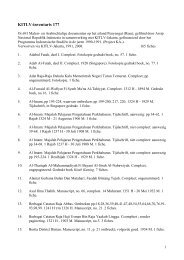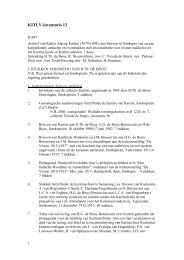The Acehnese past and its present state of study R. Michael ... - kitlv
The Acehnese past and its present state of study R. Michael ... - kitlv
The Acehnese past and its present state of study R. Michael ... - kitlv
You also want an ePaper? Increase the reach of your titles
YUMPU automatically turns print PDFs into web optimized ePapers that Google loves.
<strong>The</strong> <strong>Acehnese</strong> <strong>past</strong> <strong>and</strong> <strong>its</strong> <strong>present</strong> <strong>state</strong> <strong>of</strong> <strong>study</strong> 5<br />
the Pasai court’s most impressive entertainments, including performances by<br />
dancing horses, were similar to those he had seen performed for ‘the king <strong>of</strong><br />
India’ (Ibn Battuta n.y. :478-81). All <strong>of</strong> this points to the signifi cant degree <strong>of</strong><br />
interactions between Pasai <strong>and</strong> the Muslim cultures that were developing in<br />
South Asia during the post-Abbasid period. 5<br />
By that time, the prosperity <strong>of</strong> Pasai had helped it to become a leading<br />
centre <strong>of</strong> Muslim culture in the Indonesian Archipelago, particularly in the<br />
transmission <strong>of</strong> Islamic religious knowledge <strong>and</strong> the production <strong>of</strong> Malay<br />
literature (Roolvink 1965). <strong>The</strong> importance <strong>of</strong> Pasai as a centre for the<br />
development <strong>of</strong> Malay as a major language <strong>of</strong> Islamicate culture is attested<br />
by some <strong>of</strong> the earliest surviving texts from the region, such as the Hikayat<br />
Muhammad Hanafi yyah, the Hikayat Amir Hamza <strong>and</strong> the Hikayat Dhu’l-<br />
Qarnayn. 6 <strong>The</strong> centrality <strong>of</strong> Pasai as a Muslim cultural, economic <strong>and</strong> political<br />
centre was, however, eclipsed during the sixteenth century by the rise <strong>of</strong> a<br />
new sultanate situated at B<strong>and</strong>a Aceh (Andaya 2008:118). <strong>The</strong> ascendance<br />
<strong>of</strong> Aceh as a new maritime power in the Stra<strong>its</strong> <strong>of</strong> Malacca was forcefully<br />
announced with the 1521 rout <strong>of</strong> a Portuguese fl eet. Over the century that<br />
followed, the Sultanate <strong>of</strong> Aceh continued to clash with the Portuguese 7 as it<br />
projected <strong>its</strong> exp<strong>and</strong>ing infl uence not only eastward across the stra<strong>its</strong> to the<br />
Malay Peninsula, but also southward into the Batak <strong>and</strong> Minang l<strong>and</strong>s. 8<br />
<strong>Acehnese</strong> interactions with the Portuguese continued until the early<br />
nineteenth century <strong>and</strong> developed in complex <strong>and</strong> multifarious ways, with<br />
documents written in Portuguese remaining important sources for the early<br />
history <strong>of</strong> the <strong>Acehnese</strong> sultanate. Jorge Santos Alves’ essay in this volume<br />
<strong>present</strong>s an introduction to <strong>and</strong> overview <strong>of</strong> such Portuguese-language<br />
documents, arranged thematically so as to highlight the diversity <strong>of</strong> such<br />
sources. This typology allows us to appreciate the range <strong>of</strong> perspectives<br />
<strong>present</strong>ed by merchants, missionaries, cartographers <strong>and</strong> captives alongside<br />
those <strong>of</strong> royal missives <strong>and</strong> <strong>of</strong>fi cial documents composed under the auspices<br />
<strong>of</strong> the Estado da Índia.<br />
Complex interactions with various parts <strong>of</strong> the Muslim world involved<br />
economic, political <strong>and</strong> even (proposed) military operations. One <strong>of</strong> the most<br />
famous episodes <strong>of</strong> this type involved the Ottomans. In his contribution to<br />
this volume, İsmail Hakkı Göksoy provides a detailed review <strong>of</strong> documents<br />
5 For the broader context <strong>of</strong> these developments in the Indian sub-continent, see Wink 2004.<br />
6 <strong>The</strong>se texts <strong>and</strong> their place in the development <strong>of</strong> Malayo-Muslim culture are further discussed<br />
in Teuku Isk<strong>and</strong>ar’s contribution to this volume (Chapter III).<br />
7 For a nuanced <strong>study</strong> <strong>of</strong> one contemporary account <strong>of</strong> this confl ict framed in explicitly religious<br />
terms, see Subrahmanyam 2009.<br />
8 <strong>The</strong> interaction <strong>of</strong> Aceh <strong>and</strong> Minangkabau in particular has resulted in complex <strong>and</strong> ongoing<br />
commercial contact <strong>and</strong> exchange in both directions over the <strong>past</strong> four centuries, for example,<br />
with pepper cultivation <strong>and</strong> the Jame’ (West Sumatran) ulama.




